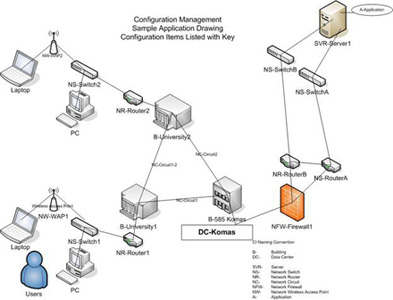Configuration Management for IT
How we turn this puzzle of information
Into organized Views like this with Configuration Management

This is the 5th email of a series on ITIL here at the University. You may have heard the term CMDB (Configuration Management Database). On the outside, it seems like the End All to Databases that keep our tribal knowledge of how everything is connected within IT. It takes the pieces like the puzzle picture (top picture) into organized views like the layout of the sample application diagram (above). Configuration Management is more than one database. It is many databases that keep track of the items we work with in IT and the relationships between them. Some of the items, called CIs (configuration items), include hardware, software, IT services, business processes, ITSM processes and documentation. With this information, we can build a virtual model of the IT infrastructure.
Configuration Management ties into other IT processes, for example:
Incident Management
Problem Management
Change Management
Release Management
Service Desk
IT Service Continuity (DR)
Availability Management
Service Level Management
It is not enough to have databases on all of the configuration items, but to keep the information up to date. This will be a Critical Success Factor (CSF) for Configuration Management.
When changes are made through the Change Management process, information from the RFC is used to help keep the CMDB up to date. For example if a change is being made to a server, then the Configuration Item (CI) should be updated in the CMDB. Submitting RFCs for all changes to CIs will help ensure the CMDB is current. Everyone making changes needs to help with the process of keeping the CMDB up to date.
We do not have a tool in place to keep track of the CMDB as of yet. Altiris will have a CMDB in their next release, but that is not until at least January of 2011. For now, we will be gathering or creating Visio drawings of how or applications and/or services are setup. Our focus will be Tier 1 applications like Cerner, EPIC and others.
A naming convention will also be needed. To rename everything in the environment at one time will not be possible. We might add a prefix to existing devices to help clarify what the CI is. For example, SVR-olympus51 would indicate the CI is a server named olympus51. Above you will find a Visio diagram that shows what an application might look like with all of the connections.
With this we will be contacting the many groups to find out how you keep your information now, and how you keep it up to date. Please share with us the information you have.
Benefits include:
• For Management
o Improved financial planning
o Improved resource allocation
• For Operations
o Accelerate Accurate Diagnosis (Incidents and Problems)
o Monitoring (identifying what is attached to this device, upstream and downstream)
o Support successful Change and Release Management (knowing what is connected to the device that is being changed.
• Planning Information
o IT Service Continuity Management (what we have to have in place if a disaster strikes).
o Availability Management (helps Service Level Management)
o Capacity Management (helps Service Level Management)
For more information about the Configuration Management process or any of the ITIL processes, please visit our web site at http://itil.it.utah.edu .
If you have any comments or suggestions on our Configuration Management process, feel free to contact Brandon Marsh (brandon.marsh@hsc.utah.edu), or Steve Penfold (steve.penfold@hsc.utah.edu).

